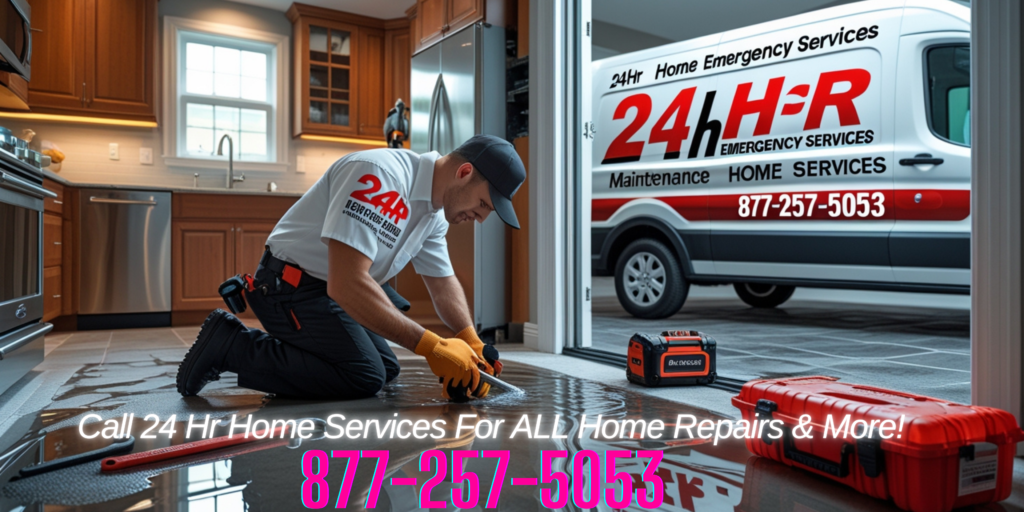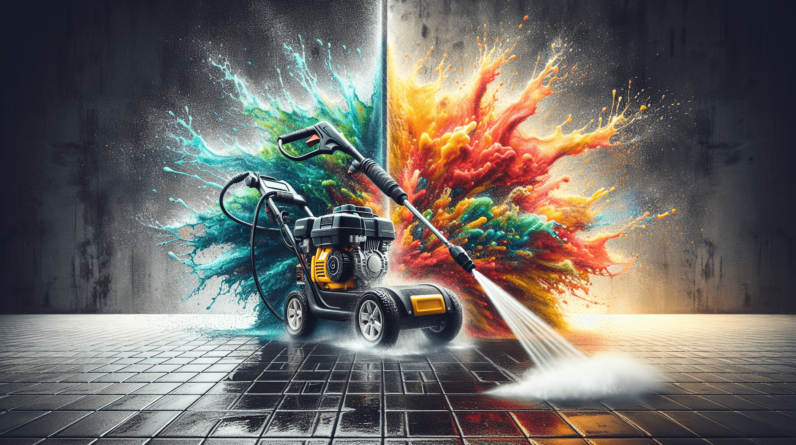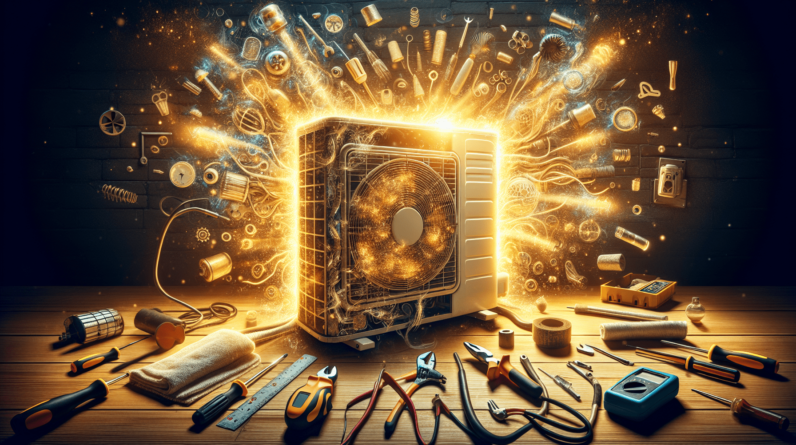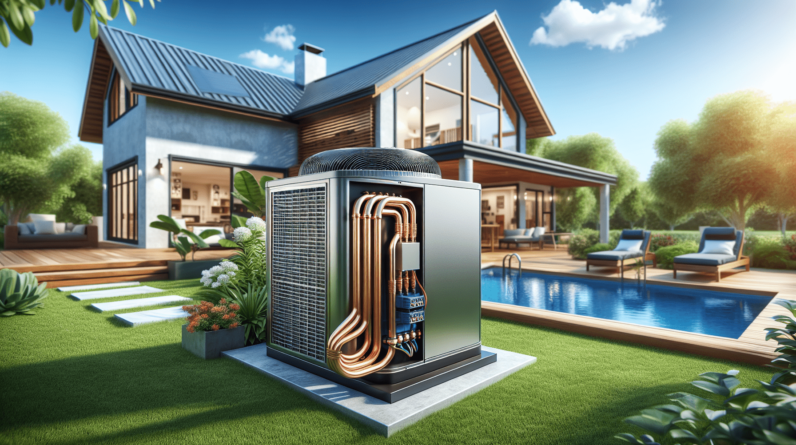

You come home from a long day at work and discover water pooling on your kitchen floor. Panic sets in as you try to determine the source of the problem. Is it a burst pipe or just a minor leak? In this article, we will explore the key differences between these two plumbing issues, helping you understand how to identify and address them effectively. Whether you’re a homeowner or a renter, having the knowledge to distinguish between a burst pipe and a leak can save you time, money, and stress.

Common Causes of Water Leaks
Pipe corrosion
Pipe corrosion is a common cause of water leaks in both residential and commercial properties. Over time, pipes can become corroded due to the constant exposure to water and the chemicals present in it. Corrosion weakens the integrity of the pipes, making them susceptible to leaks or even bursting.
High water pressure
High water pressure can put excessive strain on pipes, causing them to develop leaks. When the water pressure is too high, it creates unnecessary stress on the pipes, leading to small cracks or holes that allow water to escape. Monitoring and regulating water pressure can help prevent leaks from occurring.
Tree root intrusion
In some cases, the roots of trees can intrude into underground pipes, causing them to crack or break. This is especially common in older properties where the pipes may have deteriorated over time. Tree root intrusion can lead to significant water leaks, so it’s important to regularly inspect the area around your pipes and address any issues before they worsen.
Faulty plumbing installation
Improper installation of plumbing systems can also contribute to water leaks. If pipes are not connected or sealed correctly, they are prone to leaks. It’s crucial to hire experienced and qualified professionals for any plumbing installation or repair work to avoid potential leaks caused by poor craftsmanship.
Extreme temperature changes
Extreme temperature changes, such as freezing or rapid heating, can cause pipes to expand and contract. This repetitive stress can weaken the pipes and eventually lead to leaks or even burst pipes. Proper insulation of pipes in areas prone to extreme temperature changes can help prevent water leaks.
Signs of a Water Leak
Unexplained increase in water bills
One of the most common signs of a water leak is a sudden and unexplained increase in water bills. If you notice a significant hike in your water charges without any changes in your water usage, it’s likely that a leak is the culprit. Monitoring your water bills can help you catch leaks early and avoid excessive water wastage.
Water stains or discoloration on walls or ceilings
Water stains or discoloration on walls or ceilings are clear indicators of a water leak. If you notice patches of discoloration or staining, it’s essential to investigate the source of the leak and address it promptly. Ignoring these signs can lead to more severe damage and mold growth.
Damp or musty odor
Another sign of a water leak is the presence of a damp or musty odor in your home. When water seeps into walls, floors, or carpets, it creates a moist environment that promotes the growth of mold and mildew. The musty smell is a telltale sign that there is a hidden water leak that needs to be addressed.
Mold or mildew growth
If you spot mold or mildew growth in your home, it’s a clear indication of a water leak. Mold thrives in moist environments, making hidden water leaks a prime breeding ground. Not only can mold cause damage to your property, but it can also have adverse health effects. Identifying and fixing the source of the leak is crucial to prevent further mold growth.
Sound of running water when all fixtures are off
If you hear the sound of running water when all faucets and fixtures are turned off, it’s a strong indication of a water leak. This could be due to a hidden leak in the walls or under the floors. It’s important to investigate the source of the sound to prevent significant water damage and unnecessary water wastage.
Detecting and Locating Water Leaks
Checking water meter
One way to detect a water leak is by checking your water meter. Start by turning off all water fixtures and making sure that no appliances or irrigation systems are using water. Take note of the meter reading and wait for a few hours without using any water. If the reading changes, it indicates that there is a water leak somewhere in your plumbing system.
Using a water leak detection device
Water leak detection devices are handy tools that can help you identify the location of a water leak. These devices use sound or heat sensors to detect the presence of water and pinpoint the source of the leak. By using a water leak detection device, you can save time and effort in locating and fixing the leak.
Inspecting visible pipes and fittings
Another method of detecting water leaks is to visually inspect any visible pipes and fittings in your property. Look for signs of moisture, discoloration, or water stains around pipes, joints, and faucets. Also, check for any signs of corrosion or damage. If you notice any abnormalities, it’s a good idea to further investigate and fix the issue before it worsens.
Carrying out a dye test
A dye test can help identify leaks in toilets and other fixtures. To perform a dye test, add a few drops of food coloring into the toilet tank and wait for a few minutes without flushing. If you see the colored water appearing in the toilet bowl, it indicates a leak. This test can also be performed on other fixtures, such as sinks and showers, by applying the dye to the area where the fixture meets the wall or floor.
Conducting a pressure test
A pressure test involves pressurizing your plumbing system to check for any leaks. This test requires specialized equipment and is best performed by a professional plumber. By conducting a pressure test, you can identify any weak spots in your plumbing system that may be prone to leaks and take appropriate measures to address them.
Dealing with Water Leaks
Shutting off the main water supply
If you discover a water leak in your home, the first step is to shut off the main water supply. This will stop the flow of water and prevent further damage. Locate the main water shut-off valve, which is typically located near the water meter or where the main water line enters your property. Turn the valve clockwise to shut off the water supply.
Contacting a professional plumber
When dealing with water leaks, it’s important to contact a professional plumber to assess the situation and provide the necessary repairs. A qualified plumber has the knowledge and experience to locate and fix the leak efficiently and effectively. Attempting to fix a water leak yourself without the proper expertise can lead to further damage or ineffective repairs.

Repairing or replacing damaged pipes
Once the source of the water leak has been identified, the plumber will repair or replace the damaged pipes. Depending on the extent of the damage, this may involve patching up small leaks, replacing sections of pipe, or even rerouting the plumbing system. It’s crucial to address the underlying cause of the leak to prevent future issues.
Drying and restoring affected areas
After the water leak has been fixed, it’s important to thoroughly dry and restore any areas that have been affected by water damage. This may involve removing wet materials, such as carpets or drywall, and using dehumidifiers or fans to aid in the drying process. Proper restoration ensures that your property is free from mold and further damage.
Taking preventive measures
To prevent future water leaks, it’s important to take preventive measures. Regularly inspect your plumbing system for any signs of damage or wear, and address them promptly. Consider installing a leak detection system that can alert you to any leaks before they become major issues. Taking these preventive steps can save you from the hassle and expense of dealing with water leaks in the future.
Causes and Effects of Burst Pipes
Freezing temperatures
One of the primary causes of burst pipes is freezing temperatures. When water inside the pipes freezes, it expands, causing immense pressure on the pipe walls. This pressure can lead to cracks or ruptures in the pipes, resulting in burst pipes. In areas prone to freezing temperatures, insulating pipes, and letting faucets drip can help prevent freezing and bursting.
Excessive water pressure
High water pressure can also cause pipes to burst. When the pressure of the water flowing through the pipes exceeds their tolerance limits, it puts them at risk of bursting. Monitoring water pressure and installing pressure regulators can help prevent burst pipes caused by excessive water pressure.
Old and deteriorated pipes
As pipes age, they naturally become more susceptible to damage and bursting. Over time, pipes can weaken, corrode, or deteriorate, making them prone to bursting. Regular maintenance and inspections of your plumbing system can help identify aging pipes and allow for timely repairs or replacements, preventing potential burst pipes.
Blockages and clogs
Blockages or clogs in pipes can create pressure build-up, which can eventually lead to burst pipes. It’s crucial to address clogs and blockages as soon as they occur to prevent excessive pressure and potential damage to the pipes. Regular drain cleaning and avoiding flushing inappropriate items down the toilet or sink can help prevent blockages.
Foundation shifts
Foundation shifts can put stress on underground pipes, causing them to crack or burst. Changes in the soil composition, settling of the foundation, or seismic activity can all contribute to foundation shifts. Monitoring the condition of your property’s foundation and addressing any issues promptly can help prevent burst pipes caused by foundation shifts.
Indications of a Burst Pipe
No water flow from faucets
When a pipe bursts, it can cause a complete loss of water flow from faucets and fixtures. If you turn on a faucet and there is no water coming out, it’s a strong indicator that you may have a burst pipe. It’s important to take immediate action to prevent further damage and water wastage.
Water gushing from a visible pipe
In some cases, a burst pipe may result in water gushing out of a visible pipe. This is a clear indication of a burst pipe and requires immediate attention. Shutting off the main water supply and contacting a plumber should be your first steps to get the situation under control.
Waterlogged areas or pooling water
Burst pipes can cause water to accumulate in certain areas, leading to waterlogged areas or pooling water. If you notice damp spots on walls, floors, or ceilings, or if you see water pooling in specific areas of your property, it’s likely that you have a burst pipe. Locating and repairing the burst pipe should be your top priority to prevent further damage.
Low water pressure
While a burst pipe can result in a loss of water flow, it can also cause a decrease in water pressure. If you notice a significant drop in water pressure throughout your property, it’s important to investigate the cause. A burst pipe may be the culprit, and addressing it promptly can help restore normal water pressure.
Unusual sounds coming from pipes
A burst pipe may cause unusual sounds coming from your plumbing system. You may hear hissing, banging, or gurgling sounds as water escapes through the burst pipe. If you notice any unusual sounds coming from your pipes, it’s important to investigate the source and take appropriate action to prevent further damage.
Steps to Take When a Burst Pipe Occurs
Turn off the main water supply
When a burst pipe occurs, the first and most crucial step is to turn off the main water supply. This will stop the flow of water and prevent further damage. Locate the main water shut-off valve and turn it clockwise to shut off the water supply. It’s important to familiarize yourself with the location of the shut-off valve beforehand to be prepared for emergencies.
Open faucets and drains
After shutting off the main water supply, open all faucets and drains in your property. This will help relieve any remaining pressure in the plumbing system. By allowing the water to flow out, you can minimize the extent of water damage and prevent additional bursting of pipes.
Locate the burst pipe
Once the water flow has been stopped and the pressure has been relieved, you can begin locating the burst pipe. Inspect visible pipes and fittings for any obvious signs of damage, such as cracks or holes. If the location of the burst pipe is not readily visible, it’s best to consult a professional plumber who can use specialized equipment to locate the exact source of the leak.
Contain and remove the water
While waiting for a professional plumber to arrive, it’s important to contain and remove any water that has leaked from the burst pipe. Use buckets, towels, or a wet vacuum to soak up and remove the water. This will help prevent further damage to your property and mitigate the risk of mold or mildew growth.
Call a professional plumber
Contacting a professional plumber is essential when dealing with a burst pipe. A skilled plumber will have the expertise and specialized tools to quickly and effectively repair or replace the damaged pipe. They will also be able to assess the extent of the damage, suggest any necessary preventive measures, and ensure the integrity of your plumbing system.
Immediate Actions for Burst Pipe Emergencies
Shutting off electrical power
In the event of a burst pipe, it’s important to shut off the electrical power to affected areas if there is a risk of water coming into contact with electrical outlets or wiring. This can help prevent electrical hazards and ensure your safety. If you are unsure about how to safely shut off the electricity, contact a professional electrician for assistance.
Removing valuable items from affected areas
When a burst pipe occurs, it’s crucial to remove any valuable items or belongings from the affected areas. Move furniture, electronics, and other valuable possessions to a safe and dry location to prevent water damage. Taking immediate action to protect your belongings can help minimize losses.
Contacting a water damage restoration service
For severe burst pipe emergencies, it may be necessary to contact a professional water damage restoration service. These professionals are trained to handle water damage and can efficiently remove excess water, dry affected areas, and mitigate further damage. They can also assist with mold remediation if necessary.
Documenting the damage for insurance purposes
To ensure a smooth insurance claim process, it’s important to document the damage caused by the burst pipe. Take photos or videos of the affected areas, including any visible damage or water accumulation. Keep a record of any expenses incurred, such as repairs or restoration services. This documentation will help support your insurance claim and ensure fair compensation.
Considering temporary living arrangements
In some cases, severe burst pipe emergencies may require temporary living arrangements while repairs are being made. If your property has sustained significant water damage or if the burst pipe has affected essential utilities, such as heating or plumbing, it may be necessary to find alternative accommodation until the situation is resolved. Consider staying with family or friends, booking a hotel, or arranging temporary rentals.
Preventing Water Leaks and Burst Pipes
Insulating exposed pipes
Insulating exposed pipes is an effective way to prevent both water leaks and burst pipes. Insulation keeps the pipes protected from extreme temperature changes and reduces the likelihood of freezing or expansion. Pipe insulation can be easily installed, and it helps maintain a consistent temperature in the plumbing system, reducing the risk of leaks or bursts.
Properly maintaining plumbing fixtures
Regular maintenance of plumbing fixtures is crucial in preventing water leaks and burst pipes. Inspect faucets, toilets, and other fixtures for any signs of leaks, corrosion, or damage. Addressing any issues promptly can help prevent them from worsening and causing significant damage. Also, ensure that fixtures are properly installed, sealed, and functioning correctly.
Monitoring water pressure
Monitoring water pressure in your plumbing system can prevent the occurrence of both water leaks and burst pipes. Excessive water pressure puts unnecessary strain on pipes, increasing the risk of leaks or bursts. Install a water pressure regulator or have a professional plumber assess and regulate the water pressure in your home to ensure it stays within safe limits.
Trimming tree roots near underground pipes
If your property has underground pipes, it’s important to regularly trim tree roots near them. Tree root intrusion is a common cause of water leaks and can lead to significant damage if left unaddressed. By trimming tree roots, you can prevent them from infiltrating the pipes and causing cracks or breaks.
Installing a leak detection system
Consider installing a leak detection system in your property to provide early detection of water leaks. These systems use sensors to monitor the plumbing system for any signs of leaks or abnormal water flow. If a leak is detected, the system can send alerts, allowing you to take immediate action and prevent further damage.
Conclusion
Water leaks and burst pipes can cause significant damage to your property and lead to costly repairs. By understanding the common causes and signs of water leaks, as well as taking preventive measures, you can minimize the risk of leaks and burst pipes. Promptly addressing any leaks or burst pipes and seeking professional help when needed is crucial in mitigating damage and ensuring the safety and integrity of your plumbing system. Regular maintenance, inspections, and implementing preventive measures are key to protecting your property and avoiding the inconvenience and expense of dealing with water leaks and burst pipes.






